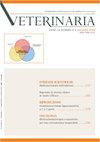商用酶联免疫吸附试验、间接免疫荧光试验和qPCR在阿尔及利亚东北部布伊拉无症状犬中诊断幼年利什曼原虫的评价
Q4 Veterinary
引用次数: 0
摘要
血清学和分子检测是确定和控制犬内脏利什曼病(CanL)的重要手段。无典型症状和无症状的狗使临床诊断困难。本研究旨在确定诊断无症状犬幼年利什曼原虫的最佳组合。从阿尔及利亚布伊拉省的狗身上采集了94份血液样本,并用IFAT、ELISA和qPCR进行了评估。与间接荧光抗体试验(IFAT)比较,评估了每种技术的敏感性和特异性,IFAT被认为是确定婴儿乳杆菌存在的最合适的试验。此外,还评估了这些试验之间的一致性。Cohen’s Kappa系数的使用表明IFAT和qPCR之间的一致性中等(k= 0.475), IFAT和ELISA之间的一致性一般(k=0.297)。分子检测的灵敏度(55.56%)高于ELISA(33.33%)。根据这些结果,对于CanL的诊断,最好将两种测试结合起来,特别是对于无症状犬,一般不包括在CanL控制程序中。本文章由计算机程序翻译,如有差异,请以英文原文为准。
EVALUATION OF COMMERCIAL ELISA, INDIRECT IMMUNOFLUORESCENCE TEST AND qPCR FOR THE DIAGNOSIS OF LEISHMANIA INFANTUM IN ASYMPTOMATIC DOGS FROM BOUIRA, NORTHEAST ALGERIA
Serological and molecular tests are important tools to determine and control Canine visceral leishmaniasis (CanL). The absence of pathognomonic symptoms and asymptomatic dogs make clinical diagnosis difficult. This study aims to determine the best combination for the diagnosis of Leishmania infantum in asymptomatic dogs. Ninety-four blood samples were collected from dogs in the province of Bouira, in Algeria and assessed with IFAT, ELISA, and qPCR. The sensitivity and specificity for each technique were evaluated in comparison with the indirect fluorescent antibody test (IFAT), which is considered the bestsuited test to determine the presence of L. infantum. In addition, the agreement between these tests was assessed. The use of Cohen’s Kappa coefficient demonstrated a moderate agreement between IFAT and qPCR (k= 0.475), and fair between the IFAT and ELISA (k=0.297). The sensitivity of the molecular test was higher (55.56%) than that of the ELISA (33.33%). According to those results, it is better to combine two tests for the diagnosis of CanL, especially in asymptomatic dogs, which is generally not included in the CanL control program.
求助全文
通过发布文献求助,成功后即可免费获取论文全文。
去求助
来源期刊

Veterinaria
农林科学-兽医学
CiteScore
0.10
自引率
0.00%
发文量
21
审稿时长
>12 weeks
期刊介绍:
VETERINARIA is the official scientific journal of the Italian Companion Animal Veterinary Association (SCIVAC) and is published bimonthly by Edizioni Veterinarie (E.V.). Its aim is to promote the spread and development of new ideas and techniques in the field of clinical and veterinary practices, with the ultimate goal of improving and promoting the continuing education of veterinary practicioners. VETERINARIA publishes literature reviews, original articles, diagnostic corners and clinical cases on different topics related to medicine and surgery of the dog, cat and of other companion animals, as well as short communications from congresses.
 求助内容:
求助内容: 应助结果提醒方式:
应助结果提醒方式:


